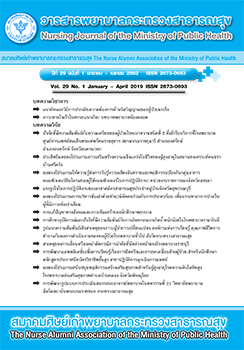Incidence and Factors Related to the Low Birth Weight Newborns in Ramathibodi Hospital
Main Article Content
Abstract
A retrospective cohort study was conducted to investigate the incidence and related factors of the low birth weight newborns in Ramathibodi Hospital. The research participants consisted of 725 mothers who had newborns weighing less than 2,500 grams, from January 2014 to June 2016. The research instrument was an information record form that is applied from the concept risk factors of low birth weight. The World Health Organization form was divided into 3 sections: personal data, health data, and complications during pregnancy data. The data were collected from medical and labour records. The data were analyzed using descriptive and chi-square statistics. The result of this study found that the incidence of low birth weight among newborns were 10.88%, 13.09% and 15.02%, from January 2014 to June 2016, respectively. The data showed a preterm low birth weight of 65.50% and term low birth weight of 34.50%. Term low birth weight accounted for one third of all low birth weight newborns. Statistically significant factors correlated with preterm and term low birth weight were total weight gain (p=.001), preterm birth history (p=.028), number of fetuses (p=.019), pregnancy induced hypertension (p=.000) and antepartum hemorrhage (p=.036). The results of the study suggest that nurses should develop proactive antenatal care to prevent the occurrence of low birth weight newborns. Moreover, health education of the risk factors for LBW should be provided to pregnant women in order that the awareness upon warning signs will be enhanced. Especially, for the term low birth weight, nurses should be able to assess, prevent and solve problem from early pregnancy.
Article Details
บทความและรายงานวิจัยในวารสารพยาบาลกระทรวงสาธารณสุข เป็นความคิดเห็นของ ผู้เขียน มิใช่ของคณะผู้จัดทำ และมิใช่ความรับผิดชอบของสมาคมศิษย์เก่าพยาบาลกระทรวงสาธารณสุข ซึ่งสามารถนำไปอ้างอิงได้
References
2. Prakong T. Related Factors of Low Birth Weight Infant. Journal of Yala Rajabhat. 2011; 6(2):114-22. (in Thai).
3. Gupta ND, Deding M, Lausten M., The effect of low birth on height, weight and behavioral outcomes in the medium-run. Economics and Human Biology. 2013; 42-55.
4. The Eleventh National Economic and Social Development Plan (2009-2011). Ministry of Public Health, Nonthaburi. 2011.
5. Information Division. The number of live births by birth weight and gestational age (2013-2014). Faculty of Medicine Ramathibodi Hospital, Mahidol University. 2016.
6. Sunsanee H, Pongsri S. Risk Factors for Low Birth Weight Babies in Health Center 6. 2007 (internet). (cited 2016 Dec 19). Available from: http://203.157.71.149/nuke/index.php/modules.php?name=News&file=article&sid=45
7. Punpit W, Kannika S, Ubonrat P. Factors Affecting the Low Birth Weight. Thai Pediatric Journal. 2008; 15(1): 34-9. (in Thai).
8. Lumbanraja S, Lutan D, Usman I. Maternal weight gain and correlation with birth weight infants. Procedia-Social and Behavioral Sciences. 2013; 103: 647-56.
9. Mahande MJ, MH, Mboya IB, Msuya SE, John B, Obure J. P37 Incidence and recurrence risk of birth weight in Northern Tanzania-A Registry based study. Pregnancy Hypertension: An international Journal of Womwn’s Cardiovascular Health.2017; 9:36-63.
10. WHO Technical Consultation, ‘Towards the development of a strategy for promoting optimal fetal growth’, Report of a meeting (draft), World Health Organization, Geneva, 2004.
11. Su RN, Zhu WW, Wei YM, Wang C, Feng H, Lin L, Yang HX. Maternal and neonatal outcomes in multiple pregnancy: A multicenter study in the Beijing population. Chronic Diseases and Translational Medicine. 2015; 1: 197-202.
12. Ediriweera SD, Dilina N, Perera U, Flores F, Samita S. Risk of low birth weight on adulthood hypertension-evidence from a tertiary care hospital in a South Asian country, Sri Lanka: a retrospective cohort study. BMC Public Health. 2017; 17: 358.
13. Sharami SH, Darkhaneh RF, Zahiri Z, Milani F, Asgharnia M, Shakiba M, et al. The relationship between vaginal bleeding in the first and second trimester of pregnancy and preterm labor. Iran J Reprod Med. 2013; 11(5): 385-90.

